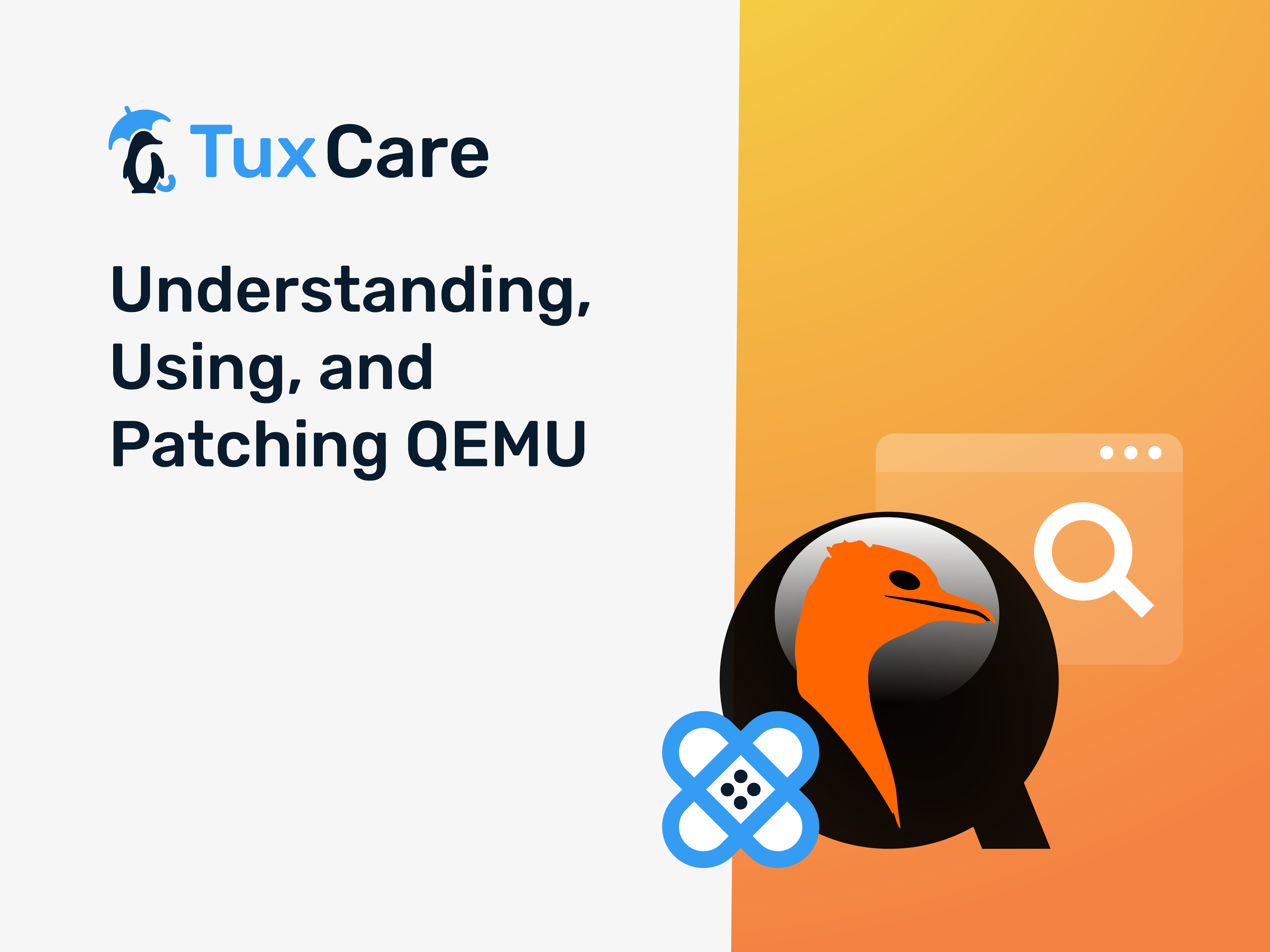Understanding, Using, and Patching QEMU
No matter which tech stack you depend on, you can be sure it’s composed of plenty of building blocks – lots of moving parts stacked on top of one another, all doing their part. Nowadays, tech stacks can get so complex that sometimes you don’t even know you’re relying on a key tool to make it all work.
The Quick EMUlator, more commonly known as QEMU, is one of those tools that work busily in the background. But what is QEMU, why is it used in the Linux world – and what do you need to think about when patching it? Let’s take a look.
First, a Primer on Virtualization
Virtualization emulates the physical hardware of a computer system, acting as a layer between the hardware and OS. Ordinarily, it would be one OS per machine, but virtualization enables multiple operating systems to run on a single physical machine. It creates a flexible and efficient way to allocate and manage resources, such as processing power, memory, and storage.
You can divide virtualization technologies into two main categories: full virtualization and paravirtualization. Full virtualization allows the creation of a virtual environment that is fully isolated from the underlying physical system and can run an unmodified operating system without any performance degradation.
Paravirtualization, on the other hand, requires that the virtual environment be aware of the underlying physical system, and requires the guest operating system to be modified.
What is QEMU?
The Quick EMUlator is an open-source software developed by Fabrice Bellard for creating virtual machine and emulation environments. It acts as an emulator, allowing you to run operating systems and applications designed for different hardware platforms, such as running ARM software on an x86-based PC.
QEMU is also a hypervisor, like VirtualBox, for instance, and it can emulate machine hardware like ARM boards. It’s also commonly used alongside Linux KVM, because of its processor extensions, to achieve great performance with guest instances. This is why QEMU is an excellent candidate for a hypervisor in a data center.
Who Uses QEMU?
The Quick EMUlator is widely used for a variety of purposes. Users include developers, system administrators, researchers, and students – but also large organizations that use it for specific applications or to drive efficiency across their server estates. It’s a really flexible tool, and some common use cases include:
- Enterprise organizations and governments: Many large organizations use QEMU as part of their virtualization infrastructure to run multiple operating systems on a single physical machine, thereby driving operational efficiency.
- Cloud service providers: Cloud service providers use QEMU to create virtual machines that can be rented to their customers. Instead of using a single, expensive piece of hardware per customer, cloud vendors use QEMU to efficiently offer a virtual machine to several customers by using just one physical machine.
- Embedded systems developers: QEMU can be used to develop and test embedded systems. These small, specialized computer systems are built into all sorts of devices, but require a testing platform for development.
- Hardware vendors: Hardware vendors use QEMU to test and validate their hardware products, as well as to develop device drivers.
- Academic and research organizations: QEMU is widely used in academic and research organizations for teaching and research. QEMU is also a great way to teach computer architecture, operating systems, and virtualization, as well as for conducting research in these areas.
As you can see, QEMU is an emulation and virtualization tool that works under a wide range of circumstances – and it’s no wonder then that QEMU is so widely in use.
How QEMU Compares to Other Alternatives
QEMU is one of the most widely used virtualization technologies, so it’s often compared to other tools such as VirtualBox, VMware, and KVM.
KVM (Kernel-based Virtual Machine) is a virtualization platform that is built into the Linux kernel. It provides a high level of performance and a low overhead, and it is tightly integrated with the Linux operating system.
KVM is often used for large-scale virtualization projects, and it is particularly popular in the data center market. However, KVM requires a Linux host, and it may not be the best choice for users who require virtualization on other operating systems.
VirtualBox is similar to QEMU in some ways, but its focus is on desktop virtualization, while QEMU is focused on server virtualization. For desktop users, it’s a great tool thanks to its user-friendly interface and simple setup process.
That said, VirtualBox is not intended for use in the enterprise environment, you won’t be using VirtualBox to support thousands of virtual instances, for example. QEMU may also be a better fit for jobs like scientific research.
VMware is a commercial virtualization platform with an advanced feature set that makes it particularly adept at managing very large numbers of virtual clients. VMware is popular in the enterprise market but, unlike QEMU, which is open source, VMware is proprietary technology and is more expensive than QEMU.
Patching Trips Things Up
Like any other piece of critical software, QEMU needs to be patched. QEMU is susceptible to security vulnerabilities that can be exploited by malicious actors. Patches address these vulnerabilities and provide bug fixes and performance improvements.
Besides, as new operating systems and hardware are released, patches to QEMU can ensure compatibility with the latest technologies, allowing for seamless virtualization of new systems – while adding new features and capabilities too. Patching is clearly essential, but patching performed the manual way also comes with some drawbacks:
- Downtime and disruption: Updating a QEMU virtual machine typically requires shutting down the virtual machine and patching the underlying host. This means downtime for the virtual machine, which is disruptive for applications that require high availability.
- Network Interruptions: Patching a QEMU virtual machine can also result in interruptions to network connections and services running within the virtual machine. This can disrupt network-dependent applications and services, which may require additional time to restore connectivity.
- Complexity: Patching a QEMU virtual machine is often complex and time consuming, particularly in larger environments with large numbers of instances. This increases IT overhead and creates longer lead times for security and bug fixes.
- Rollback Challenges: If a patch or update to QEMU introduces issues or bugs, rolling back to a previous version may not be straightforward. This can result in prolonged downtime and disruption, as well as increased risk to data and systems if the issue is not resolved in a timely manner.
The net result of these patching challenges is that organizations often don’t patch their Quick EMUlator workloads consistently. In turn, this means that companies run versions of QEMU that are exposed to one of the many QEMU vulnerabilities.
Looking at Live Patching as a Solution
TuxCare offers a solution that makes patching QEMU much simpler – it’s called QEMUCare, an automated live patching solution for the Quick EMUlator. With live patching, you apply patches to your QEMU software while it is running, without affecting the performance or stability of QEMU – and without the need to restart the Quick EMUlator.
Thanks to QEMUCare’s live patching capabilities, you can effortlessly patch your QEMU-based virtualization systems while they are operational, without the need to shut down the virtual machines you are running on the Quick EMUlator.
This means that you can keep your infrastructure up to date with no downtime or interruption to end-users. What’s more, you can rest assured that the QEMU version that powers your virtual machines is consistently protected from the latest security threats.
QEMUCare fits in with TuxCare’s wider live patching and end-of-life solutions – you can read more about QEMUCare here.



 Documentation
Documentation Login
Login



